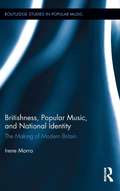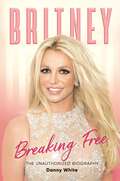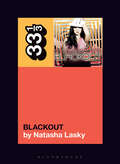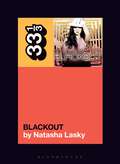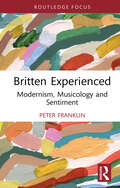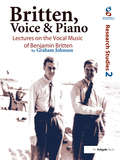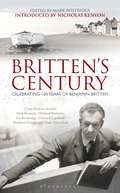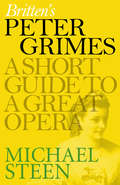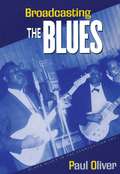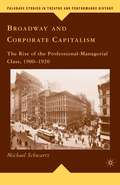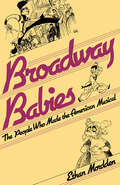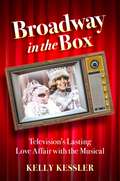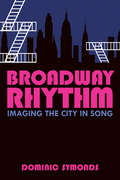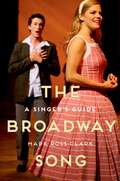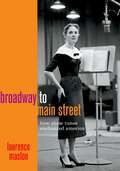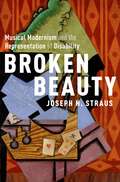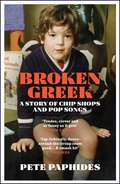- Table View
- List View
Britishness, Popular Music, and National Identity: The Making of Modern Britain (Routledge Studies in Popular Music)
by Irene MorraThis book offers a major exploration of the social and cultural importance of popular music to contemporary celebrations of Britishness. Rather than providing a history of popular music or an itemization of indigenous musical qualities, it exposes the influential cultural and nationalist rhetoric around popular music and the dissemination of that rhetoric in various forms. Since the 1960s, popular music has surpassed literature to become the dominant signifier of modern British culture and identity. This position has been enforced in popular culture, literature, news and music media, political rhetoric -- and in much popular music itself, which has become increasingly self-conscious about the expectation that music both articulate and manifest the inherent values and identity of the modern nation. This study examines the implications of such practices and the various social and cultural values they construct and enforce. It identifies two dominant, conflicting constructions around popular music: music as the voice of an indigenous English ‘folk’, and music as the voice of a re-emergent British Empire. These constructions are not only contradictory but also exclusive, prescribing a social and musical identity for the nation that ignores its greater creative, national, and cultural diversity. This book is the first to offer a comprehensive critique of an extremely powerful discourse in England that today informs dominant formulations of English and British national identity, history, and culture.
Britney: The Unauthorized Biography
by Danny WhiteShe has sold more than 150 million albums, wowed sell-out audiences around the globe and starred in iconic music videos but Britney Spears’ success has come with an unbearable price tag.This biography uncovers the story of how this church-going girl from the Deep South became an objectified teenage sensation and the princess of pop. It follows her rollercoaster existence from the top of the charts to the despair of a very public mental health crisis.Go behind the scenes of Britney’s battle to free herself from her notorious conservatorship and the impact it had on this highly talented but fragile woman, whose cultural and social influence is fast approaching that of Marilyn Monroe.This book lifts the lid on the controversies that have plagued her life, covers her romances and celebrates her many remarkable triumphs. Along the way, we learn much about show-business and society itself.As she enters her fifth decade in the relentless glare of the spotlight, this is a compelling and intimate portrait of the real Britney and brings her story up to date, revealing what will come next for this fascinating star, who has perfected the art of reinvention.
Britney Spears's Blackout (33 1/3)
by Natasha LaskyBritney Spears barely survived 2007. She divorced her husband, lost custody of her kids, went to rehab, shaved her head and assaulted a paparazzo. In the midst of her public breakdown, she managed to record an album, Blackout. Critics thought it spelled the end for Britney Spears' career.But Blackout turned out to be one of the most influential albums of the aughts. It not only brought glitchy digital noise and dubstep into the Top 40, but also transformed Britney into a new kind of pop star, one who shrugged off mainstream ubiquity for the devotion of smaller groups of fans who worshipped her idiosyncratic sound.This book returns to the grimy clubs and paparazzi hangouts of LA in the 2000s as well as the blogs and forums of the early internet to show how Blackout was a crucial hinge between twentieth and twenty-first-century pop.
Britney Spears's Blackout (33 1/3)
by Natasha LaskyBritney Spears barely survived 2007. She divorced her husband, lost custody of her kids, went to rehab, shaved her head and assaulted a paparazzo. In the midst of her public breakdown, she managed to record an album, Blackout. Critics thought it spelled the end for Britney Spears' career.But Blackout turned out to be one of the most influential albums of the aughts. It not only brought glitchy digital noise and dubstep into the Top 40, but also transformed Britney into a new kind of pop star, one who shrugged off mainstream ubiquity for the devotion of smaller groups of fans who worshipped her idiosyncratic sound.This book returns to the grimy clubs and paparazzi hangouts of LA in the 2000s as well as the blogs and forums of the early internet to show how Blackout was a crucial hinge between twentieth and twenty-first-century pop.
Britten Experienced: Modernism, Musicology and Sentiment
by Peter FranklinWho writes the books we read about music that excites us, and why? Is ‘classical music’ all about class? Related questions underpin this partly polemical study, written by an academic who believes that the Humanities, to be really humane, must confront their methods and aims. Two recent studies of Benjamin Britten have specifically interested the author, who was educated in a world where the composer was a living subject of criticism and praise, his works reflecting values, worries and dramas that were not just about ‘music’. Franklin’s response is to question the recent writers, proposing that, like theirs, his own story conditioned when and how he experienced Britten. This he unfolds autobiographically in and around the discussion of specific works. Recalling his encounters with the composer as a schoolboy, as a student and opera-goer, and then as a teacher, he challenges recent assertions about Britten and modernism in the period.
Britten Experienced: Modernism, Musicology and Sentiment
by Peter FranklinWho writes the books we read about music that excites us, and why? Is ‘classical music’ all about class? Related questions underpin this partly polemical study, written by an academic who believes that the Humanities, to be really humane, must confront their methods and aims. Two recent studies of Benjamin Britten have specifically interested the author, who was educated in a world where the composer was a living subject of criticism and praise, his works reflecting values, worries and dramas that were not just about ‘music’. Franklin’s response is to question the recent writers, proposing that, like theirs, his own story conditioned when and how he experienced Britten. This he unfolds autobiographically in and around the discussion of specific works. Recalling his encounters with the composer as a schoolboy, as a student and opera-goer, and then as a teacher, he challenges recent assertions about Britten and modernism in the period.
Britten, Voice and Piano: Lectures on the Vocal Music of Benjamin Britten
by Graham JohnsonThis collection of eight 'lectures' by internationally acclaimed pianist, Graham Johnson, is based on a series of concert talks given at the Guildhall School of Music and Drama as part of the Benjamin Britten festival in 2001. The focus of the book is on Britten's songs, starting with his earliest compositions in the genre. Graham Johnson suggests that the nature of Britten's creativity is especially apparent in his setting of poetry, that he becomes the poet's alter-ego. A chapter on Britten's settings of Auden and Eliot explores the particular influences these writers brought to bear at opposite poles of the composer's life. The inspiration of fellow musicians is also discussed, with a chapter devoted to Britten's time in Russia and his friendship with the Rostropovitch family. Closer to home, the book places in context Britten's folksong settings, illustrating how he subverted the English folksong tradition by refusing to accept previous definitions of what constituted national loyalty. Drawing on letters and diaries, and featuring a number of previously unpublished photographs, this book illuminates aspects of Britten's songs from the personal perspective of the pianist who worked closely with Peter Pears after Benjamin Britten was unable to perform through illness. Johnson worked with Pears on learning the role of Aschenbach in 'Death in Venice' and was official pianist for the first master class given by Peter Pears at Snape in 1972.
Britten, Voice and Piano: Lectures on the Vocal Music of Benjamin Britten
by Graham JohnsonThis collection of eight 'lectures' by internationally acclaimed pianist, Graham Johnson, is based on a series of concert talks given at the Guildhall School of Music and Drama as part of the Benjamin Britten festival in 2001. The focus of the book is on Britten's songs, starting with his earliest compositions in the genre. Graham Johnson suggests that the nature of Britten's creativity is especially apparent in his setting of poetry, that he becomes the poet's alter-ego. A chapter on Britten's settings of Auden and Eliot explores the particular influences these writers brought to bear at opposite poles of the composer's life. The inspiration of fellow musicians is also discussed, with a chapter devoted to Britten's time in Russia and his friendship with the Rostropovitch family. Closer to home, the book places in context Britten's folksong settings, illustrating how he subverted the English folksong tradition by refusing to accept previous definitions of what constituted national loyalty. Drawing on letters and diaries, and featuring a number of previously unpublished photographs, this book illuminates aspects of Britten's songs from the personal perspective of the pianist who worked closely with Peter Pears after Benjamin Britten was unable to perform through illness. Johnson worked with Pears on learning the role of Aschenbach in 'Death in Venice' and was official pianist for the first master class given by Peter Pears at Snape in 1972.
Britten's Century: Celebrating 100 Years of Britten
by Nicholas Kenyon Mark BostridgeBritten's Century considers various aspects of Britten's life and work. The book is written by biographers, performers and music critics. Here is a wealth of subject matter - Britten's operatic output, his orchestral works, his contribution to the revival of English song. Biographically, this book moves on beyond the relationship with Peter Pears and the salacious speculation about his infatuation with various boys, to a consideration of Britten's experience as a homosexual man living in a largely homophobic society. Another area here which is often overlooked is the view of Britten from outside the British Isles - the USA and Italy, where his operas have long been extremely popular.
Britten's Century: Celebrating 100 Years of Britten
by Nicholas Kenyon Mark BostridgeBritten's Century considers various aspects of Britten's life and work. The book is written by biographers, performers and music critics. Here is a wealth of subject matter - Britten's operatic output, his orchestral works, his contribution to the revival of English song. Biographically, this book moves on beyond the relationship with Peter Pears and the salacious speculation about his infatuation with various boys, to a consideration of Britten's experience as a homosexual man living in a largely homophobic society. Another area here which is often overlooked is the view of Britten from outside the British Isles - the USA and Italy, where his operas have long been extremely popular.
Britten's Peter Grimes: A Short Guide to a Great Opera (Great Operas)
by Michael SteenBritten’s opera Peter Grimes is based on George Crabbe’s horrifying poem The Borough about early 19th century Aldeburgh, a North Sea fishing town in East Anglia. Its premiere at Sadlers Wells in 1945, shortly after VE Day, was a landmark moment in British operatic history. Britten’s partner Peter Pears – like Britten a pacifist and conscientious objector – was in the title role. Britten and Pears, together with Montagu Slater, a communist journalist, created the libretto.Grimes, a fisherman and sadistic child abuser, is a loner longing for social acceptance, and the wealth to marry the retired schoolmistress Ellen Orford. Britten, a homosexual whose circle included E.M. Forster and Christopher Isherwood, wanted to win sympathy for outsiders. Yet after Grimes has destroyed yet another apprentice, and himself committed suicide, life just goes on as usual in the bustling, hypocritical town. ‘The Borough’ has a pompous mayor, a typical pub landlady, a drunken Methodist, an ineffectual parson, a drug-addicted rich widow. A pub brawl and barn dance conceal the dark side of this community: its hysteria, its busybodies, its lynch-mob justice. The opera and its story, as depicted in Britten’s evocative music, haunts the audience long after the curtain comes down. Written by Michael Steen, author of the acclaimed The Lives and Times of the Great Composers, ‘Short Guides to Great Operas’ are concise, entertaining and easy to read. They are packed with useful information and informed opinion, helping to make you a truly knowledgeable opera-goer, and so maximising your enjoyment of a great musical experience.Other ‘Short Guides to Great Operas’ that you may enjoy include La Bohème, Don Giovanni and Eugene Onegin.
Broadcasting the Blues: Black Blues in the Segregation Era
by Paul OliverBroadcasting the Blues: Black Blues in the Segregation Era is based on Paul Oliver's award-winning radio broadcasts from the BBC that were created over several decades. It traces the social history of the blues in America, from its birth in the rural South through the heyday of sound recordings. Noted blues scholar Paul Oliver draws on decades of research and personal interviews with performers--some of whom he "discovered" and recorded for the first time--to draw a picture of how the blues aesthetic developed, giving new insights into the role blues played in American society before racial integration. The book begins by outlining the history of the blues from African music through country stomps, ragtime songs, and field hollers. From the heroic figures of black folksong--including the steel-driving railroad worker John Henry and the destructive Boll Weevil--to the content of the emerging blues, the author discusses the "meaning" behind the often coded words of the blues, evoking topics such as playful sexuality, magic and medicine, the stresses of segregation, and commentary on national events. Finally, the author traces the history of blues documentation, showing how our views of the early blues have been shaped through a complex interplay of social forces, and indicating possible lines for future research.
Broadcasting the Blues: Black Blues in the Segregation Era
by Paul OliverBroadcasting the Blues: Black Blues in the Segregation Era is based on Paul Oliver's award-winning radio broadcasts from the BBC that were created over several decades. It traces the social history of the blues in America, from its birth in the rural South through the heyday of sound recordings. Noted blues scholar Paul Oliver draws on decades of research and personal interviews with performers--some of whom he "discovered" and recorded for the first time--to draw a picture of how the blues aesthetic developed, giving new insights into the role blues played in American society before racial integration. The book begins by outlining the history of the blues from African music through country stomps, ragtime songs, and field hollers. From the heroic figures of black folksong--including the steel-driving railroad worker John Henry and the destructive Boll Weevil--to the content of the emerging blues, the author discusses the "meaning" behind the often coded words of the blues, evoking topics such as playful sexuality, magic and medicine, the stresses of segregation, and commentary on national events. Finally, the author traces the history of blues documentation, showing how our views of the early blues have been shaped through a complex interplay of social forces, and indicating possible lines for future research.
Broadway and Corporate Capitalism: The Rise of the Professional-Managerial Class, 1900–1920 (Palgrave Studies in Theatre and Performance History)
by M. SchwartzThrough an examination of plays, actors, reviews, and audience response of the period, this study traces the development of Broadway as a source of 'mature' American drama, and the simultaneous development of Professional-Managerial Class consciousness and habitus.
Broadway Babies: The People Who Made the American Musical
by Ethan MorddenVividly recreating the unique pleasure of experiencing a song-and-dance show, Broadway Babies spotlights the men and women who made a difference in the development of American musical comedy. Mordden's account features such show people as Florenz Ziegfeld, Harold Prince, Bert Lahr, Gwen Verdon, Angela Lansbury, Victor Herbert, Liza Minnelli, and Stephen Sondheim, and such musicals as Sally, Oh Kay!, Anything Goes, Show Boat, Oklahoma!, Follies, Chicago, and countless others. While theatrical historians traditionally have emphasized the role of the authors of musicals, Mordden also examines the personal styles of the directors, choreographers, and producers, in order to demonstrate not only what the musical became but what it was. The volume includes an extensive discography--the first of its kind--which offers a virtually self-contained history of recorded show music.
Broadway in the Box: Television's Lasting Love Affair with the Musical
by Kelly KesslerIt was as if American television audiences discovered the musical in the early 21st century. In 2009 Glee took the Fox Network and American television by storm with the unexpected unification of primetime programming, awkward teens, and powerful voices spontaneously bursting into song. After raking in the highest rating for a new show in the 2009-2010 season, Glee would continue to cultivate rabid fans, tie-in soundtracks and merchandising, and a spinoff reality competition show until its conclusion in 2015. Alongside Glee, NBC and Fox would crank up musical visibility with the nighttime drama Smash and a string of live musical productions. Then came ABC's comedic fantasy musical series Galavant and the CW's surprise Golden Globe darling Crazy Ex-Girlfriend. Television and the musical appeared to be a perfect match. But, as author Kelly Kessler illustrates, television had at that point been carrying on a sixty-year, symbiotic love affair with the musical. From Rodgers and Hammerstein's appearance on the first Toast of the Town telecast and Mary Martin's iconic Peter Pan airings to Barbra Streisand's 1960s CBS specials, The Carol Burnett Show, Cop Rock, Great Performances, and a string of one-off musical episodes of sitcoms, nighttime soaps, fantasy shows, and soap operas, television has always embraced the musical. Kessler shows how the form is written across the history of American television and how its various incarnations tell the stories of shifting American culture and changing television, film, and theatrical landscapes. She recounts and explores this rich, decades-long history by traversing musicals, stars, and sounds from film, Broadway, and Las Vegas to the small screen.
BROADWAY IN THE BOX C: Television's Lasting Love Affair with the Musical
by Kelly KesslerIt was as if American television audiences discovered the musical in the early 21st century. In 2009 Glee took the Fox Network and American television by storm with the unexpected unification of primetime programming, awkward teens, and powerful voices spontaneously bursting into song. After raking in the highest rating for a new show in the 2009-2010 season, Glee would continue to cultivate rabid fans, tie-in soundtracks and merchandising, and a spinoff reality competition show until its conclusion in 2015. Alongside Glee, NBC and Fox would crank up musical visibility with the nighttime drama Smash and a string of live musical productions. Then came ABC's comedic fantasy musical series Galavant and the CW's surprise Golden Globe darling Crazy Ex-Girlfriend. Television and the musical appeared to be a perfect match. But, as author Kelly Kessler illustrates, television had at that point been carrying on a sixty-year, symbiotic love affair with the musical. From Rodgers and Hammerstein's appearance on the first Toast of the Town telecast and Mary Martin's iconic Peter Pan airings to Barbra Streisand's 1960s CBS specials, The Carol Burnett Show, Cop Rock, Great Performances, and a string of one-off musical episodes of sitcoms, nighttime soaps, fantasy shows, and soap operas, television has always embraced the musical. Kessler shows how the form is written across the history of American television and how its various incarnations tell the stories of shifting American culture and changing television, film, and theatrical landscapes. She recounts and explores this rich, decades-long history by traversing musicals, stars, and sounds from film, Broadway, and Las Vegas to the small screen.
Broadway Rhythm: Imaging the City in Song
by Dominic SymondsBroadway Rhythm is a guide to Manhattan like nothing you've ever read. Author Dominic Symonds calls it a performance cartography, and argues that the city of New York maps its iconicity in the music of the Broadway songbook. A series of walking tours takes the reader through the landscape of Manhattan, clambering over rooftops, riding the subway, and flying over skyscrapers. Symonds argues that Broadway's songs can themselves be used as maps to better understand the city though identifiable patterns in the visual graphics of the score, the auditory experience of the music, and the embodied articulation of performance, recognizing in all of these patterns, corollaries inscribed in the terrain, geography, and architecture of the city. Through musicological analyses of works by Gershwin, Bernstein, Copland, Sondheim and others, the author proposes that performance cartography is a versatile methodology for urban theory, and establishes a methodological approach that uses the idea of the map in three ways: as an impetus, a metaphor, and a tool for exploring the city.
The Broadway Song: A Singer's Guide
by Mark Ross ClarkTruly powerful vocal performance in musical theater is more than just the sum of good vocal tone and correct notes. As experienced teacher, director, and performer Mark Ross Clark lays out in The Broadway Song, powerful performance communicates the central function of a song within the context of the surrounding narrative, or the "truth" of a song. Because unstaged performances of a song, such as auditions, are key to the success of all aspiring singers, Clark provides here the essential practical manual that will help performers choose the right pieces for their vocal abilities and identify the key truths of them. Clark begins by walking readers conceptually through how a song's truth is based in contexts: what show is a song from? Which character sings it? When in the show does it occur? Answering these questions will lead readers to more convincing performances that are grounded in the text, music, character, context, and larger environment (setting, time frame, and circumstances). The Broadway Song provides a comprehensive guide to the formal characteristics of key Broadway songs on a song-by-song basis, including main voice type, secondary voice qualities (such as soprano-lyric or alto-comic), range and tessitura, as well as larger contextual materials about the source -- from the musical's background, information about the character singing, and synoptic narrative information for the song -- that provide the performer a way into the character. Clark moreover brings his wide-ranging and extensive experience as a director, performer, and teacher to bear in his performance notes on the individual pieces. Additionally, he includes excerpts from short interviews with artists that provide insight into the song from the perspective of those who first created (or re-created) it. The interviews, conducted with composers, lyricists, performers, and -- in one case -- book collaborators, are snapshots into the creative process, and act as conduits to further study of the selected songs.
BROADWAY SONG A SINGER'S GUIDE C: A Singer's Guide
by Mark Ross ClarkTruly powerful vocal performance in musical theater is more than just the sum of good vocal tone and correct notes. As experienced teacher, director, and performer Mark Ross Clark lays out in The Broadway Song, powerful performance communicates the central function of a song within the context of the surrounding narrative, or the "truth" of a song. Because unstaged performances of a song, such as auditions, are key to the success of all aspiring singers, Clark provides here the essential practical manual that will help performers choose the right pieces for their vocal abilities and identify the key truths of them. Clark begins by walking readers conceptually through how a song's truth is based in contexts: what show is a song from? Which character sings it? When in the show does it occur? Answering these questions will lead readers to more convincing performances that are grounded in the text, music, character, context, and larger environment (setting, time frame, and circumstances). The Broadway Song provides a comprehensive guide to the formal characteristics of key Broadway songs on a song-by-song basis, including main voice type, secondary voice qualities (such as soprano-lyric or alto-comic), range and tessitura, as well as larger contextual materials about the source -- from the musical's background, information about the character singing, and synoptic narrative information for the song -- that provide the performer a way into the character. Clark moreover brings his wide-ranging and extensive experience as a director, performer, and teacher to bear in his performance notes on the individual pieces. Additionally, he includes excerpts from short interviews with artists that provide insight into the song from the perspective of those who first created (or re-created) it. The interviews, conducted with composers, lyricists, performers, and -- in one case -- book collaborators, are snapshots into the creative process, and act as conduits to further study of the selected songs.
Broadway to Main Street: How Show Tunes Enchanted America
by Laurence MaslonThe music of Broadway is one of America's most unique and popular calling cards. In Broadway to Main Street: How Show Tunes Enchanted America, author Laurence Maslon tells the story of how the most beloved songs of the American Musical Theater made their way from the Theater District to living rooms across the country. The crossroads where the music of Broadway meets popular culture is an expansive and pervasive juncture throughout most of the twentieth century--from sheet music to radio broadcasts to popular and original cast recordings--and continues to influence culture today through television, streaming, and the Internet. The original Broadway cast album--from the 78 rpm recording of Oklahoma! to the digital download of Hamilton--is one of the most successful, yet undervalued, genres in the history of popular recording. The challenge of capturing musical narrative with limited technology inspired the imagination of both the recording industry and millions of listeners: between 1949 and 1969, fifteen different original cast albums hit number one on the popular music charts, ultimately tallying more weeks at number one than all of the albums by Frank Sinatra, Elvis Presley, and The Beatles combined. The history of Broadway music is also the history of American popular music; the technological, commercial, and marketing forces of communications and media over the last century were inextricably bound up in the enterprise of bringing the musical gems of New York's Theater District to living rooms along Main Streets across the nation. Featuring new interviews with Stephen Schwartz, Chita Rivera, Steve Lawrence, and prominent record producers and music critics, the story of this commercial and emotional phenomenon is told here in full--from the imprimatur of sheet music from Broadway in the early 20th century to the renaissance of Broadway music in the digital age, folding in the immense impact of show music on American culture and in the context of the recording industry, popular tastes, and our shared national identity. A book which connects cherished cultural artifacts to the emotional narratives at the core of American popular music, Broadway to Main Street: How Show Tunes Enchanted America is an ideal companion for all fans of American musical theater and popular music.
Broadway to Main Street: How Show Tunes Enchanted America
by Laurence MaslonThe music of Broadway is one of America's most unique and popular calling cards. In Broadway to Main Street: How Show Tunes Enchanted America, author Laurence Maslon tells the story of how the most beloved songs of the American Musical Theater made their way from the Theater District to living rooms across the country. The crossroads where the music of Broadway meets popular culture is an expansive and pervasive juncture throughout most of the twentieth century--from sheet music to radio broadcasts to popular and original cast recordings--and continues to influence culture today through television, streaming, and the Internet. The original Broadway cast album--from the 78 rpm recording of Oklahoma! to the digital download of Hamilton--is one of the most successful, yet undervalued, genres in the history of popular recording. The challenge of capturing musical narrative with limited technology inspired the imagination of both the recording industry and millions of listeners: between 1949 and 1969, fifteen different original cast albums hit number one on the popular music charts, ultimately tallying more weeks at number one than all of the albums by Frank Sinatra, Elvis Presley, and The Beatles combined. The history of Broadway music is also the history of American popular music; the technological, commercial, and marketing forces of communications and media over the last century were inextricably bound up in the enterprise of bringing the musical gems of New York's Theater District to living rooms along Main Streets across the nation. Featuring new interviews with Stephen Schwartz, Chita Rivera, Steve Lawrence, and prominent record producers and music critics, the story of this commercial and emotional phenomenon is told here in full--from the imprimatur of sheet music from Broadway in the early 20th century to the renaissance of Broadway music in the digital age, folding in the immense impact of show music on American culture and in the context of the recording industry, popular tastes, and our shared national identity. A book which connects cherished cultural artifacts to the emotional narratives at the core of American popular music, Broadway to Main Street: How Show Tunes Enchanted America is an ideal companion for all fans of American musical theater and popular music.
Broken Beauty: Musical Modernism and the Representation of Disability
by Joseph N. StrausPreeminent music theorist and leader in the study of music and disability Joseph Straus presents a truly groundbreaking take on musical modernism--demonstrating in an expansive and vivid multimedia presentation that modernist music is inextricably entwined with attitudes toward disability. In Broken Beauty, Straus argues that the most characteristic features of musical modernism--fractured forms, immobilized harmonies, conflicting textural layers, radical simplification of means in some cases, and radical complexity and hermeticism in others--can be understood as musical depictions of disability conditions, including deformity/disfigurement, mobility impairment, madness, idiocy, and autism. Against the traditional medical model of disability, which sees it as a bodily defect requiring diagnosis and normalization or cure, this new sociocultural model of disability sees it as cultural artifact, something that is created by and creates culture. Straus places this revised model of disability against a wide range of canonical, high-art concert music from the first decades of the century through the 1950s. Broken Beauty illustrates how disability is right at the core of musical modernism; it is one of the things that musical modernism is fundamentally about.
Broken Beauty: Musical Modernism and the Representation of Disability
by Joseph N. StrausPreeminent music theorist and leader in the study of music and disability Joseph Straus presents a truly groundbreaking take on musical modernism--demonstrating in an expansive and vivid multimedia presentation that modernist music is inextricably entwined with attitudes toward disability. In Broken Beauty, Straus argues that the most characteristic features of musical modernism--fractured forms, immobilized harmonies, conflicting textural layers, radical simplification of means in some cases, and radical complexity and hermeticism in others--can be understood as musical depictions of disability conditions, including deformity/disfigurement, mobility impairment, madness, idiocy, and autism. Against the traditional medical model of disability, which sees it as a bodily defect requiring diagnosis and normalization or cure, this new sociocultural model of disability sees it as cultural artifact, something that is created by and creates culture. Straus places this revised model of disability against a wide range of canonical, high-art concert music from the first decades of the century through the 1950s. Broken Beauty illustrates how disability is right at the core of musical modernism; it is one of the things that musical modernism is fundamentally about.
Broken Greek: Radio 4 Book of the Week
by Pete Paphides'Unflinching and heartwarming' - Adam Kay'Tender, clever and as funny as it gets ... a heart-piercing joy' - Lauren Laverne'An exceptional coming-of-age story [...] Pete Paphides may very well have the biggest heart in Britain' - Marina Hyde'I ADORE this utterly wonderful coming-of-age memoir. Joyful, clever, and a bit heartbreaking' - Nina Stibbe'Heartfelt, hilarious and beautifully written, Broken Greek is a childhood memoir like no other' - Cathy Newman'So wonderfully written, such a light touch. Drenched in sentiment yet not in the least sentimental' - John Niven'It's brilliant. Sad, really funny and beautifully written ... just fantastic' - Alexis Petridis'A truly beautiful book' - James O'Brien'Intoxicating' - Kirsty Wark'Oh, how I love Pete Paphides and this book' - Daniel Finkelstein'Lip-lickingly, dance-around-the-living-room good... A smash hit' Observer'A book that will leave you smiling' Independent 'Wonderful' Record Collector__________'Do you sometimes feel like the music you're hearing is explaining your life to you?'When Pete's parents moved from Cyprus to Birmingham in the 1960s in the hope of a better life, they had no money and only a little bit of English. They opened a fish-and-chip shop in Acocks Green. The Great Western Fish Bar is where Pete learned about coin-operated machines, male banter and Britishness.Shy and introverted, Pete stopped speaking from age 4 to 7, and found refuge instead in the bittersweet embrace of pop songs, thanks to Top of the Pops and Dial-A-Disc. From Brotherhood of Man to UB40, from ABBA to The Police, music provided the safety net he needed to protect him from the tensions of his home life. It also helped him navigate his way around the challenges surrounding school, friendships and phobias such as visits to the barber, standing near tall buildings and Rod Hull and Emu.With every passing year, his guilty secret became more horrifying to him: his parents were Greek, but all the things that excited him were British. And the engine of that realisation? 'Sugar Baby Love', 'Don't Go Breaking My Heart', 'Tragedy', 'Silly Games', 'Going Underground', 'Come On Eileen', and every other irresistibly thrilling chart hit blaring out of the chip shop radio.Never have the trials and tribulations of growing up and the human need for a sense of belonging been so heart-breakingly and humorously depicted.
